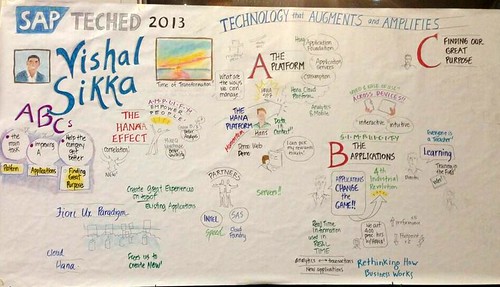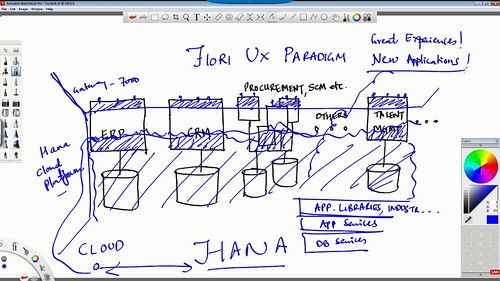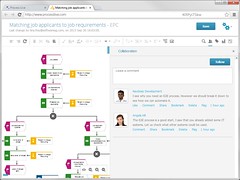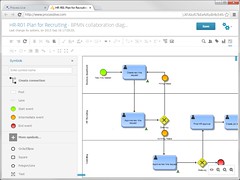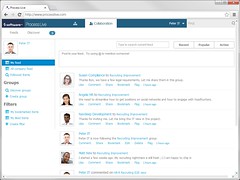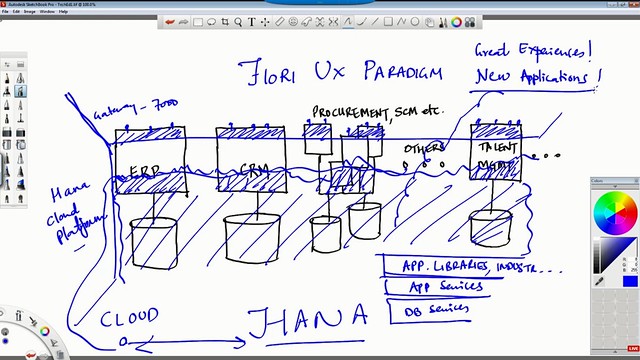A couple of weeks ago, IBM had two analyst calls about the announcements this week at IBM Connect 2013; since I’m not at the conference, I wrote most of this at that time but only published today due to embargo restrictions. It’s the 20th anniversary of Lotusphere, although the conference is no longer branded as Lotusphere since the “smarter workforce” and “smarter commerce” streams are beyond just products with a Lotus heritage or brand.
The first briefing featured Jeff Schick, who heads up social software at IBM. He discussed new software and cloud services to put social business capabilities in the hands of C-level executives in HR and marketing, covering the dual goals of managing corporate intranets and talent, and managing external marketing campaigns. The catchphrases are “Activate the Workforce” and “Delight Customers”, enabled by IBM social business solutions for Smarter Workforce and Smarter Commerce, built on the social integration capabilities of IBM WebSphere Portal.
Specific product releases coming up in the next several weeks:
- IBM Connections v4.5, with FileNet ECM now available as a native service: documents and their processes (processes within FileNet, I assume, not within IBM BPM) can be integrated into a Connections community, exposing FileNet functionality such as metadata and foldering through Connections, and providing fully integrated social capabilities such as tagging, commenting and liking, making content a first-class social citizen. This is hot. It will not include records management or Case Manager: it appears that these functions would be available on the FileNet side, but not exposed (at this time) through Connections. Quickr customers are being offered a migration path to IBM Connections Content Manager, which is a bundled FileNet repository that can be upgraded to the full ECM suite if you wanted to use it outside the Connections context. Connections can also integrate with SharePoint and Outlook, so is an option even if you’re a Microsoft customer in those areas.
- IBM Notes 9 Social Edition, competing against Outlook 2013 with social-enabled email, activity Streams and other social capabilities.
- IBM Docs for web-based collaboration, now available on-premise as well as in the cloud. This competes against Office 365 and Google Docs, but offers better collaboration than O365 (which requires passing control of a document between collaborators) and better rendering/conversion of Office documents than GDocs. IBM Docs is integrated with Connections for social features and sharing, in the same sort of way as Content Manager.
- IBM Sametime replaces their existing meeting service in the cloud, including iOS and Android support. It uses the Polycom framework for video and audio support.
- Deployment of all of this can be public cloud, private cloud, on-premise (not really sure of the distinction there) or a hybrid of these. Their SmartCloud for Social Business provides for the cloud deployment and adds wiki, blogs and other social authoring functionality. SmartCloud has Safe Harbor certification, making it a bit mire immune to government snooping, and can be private-labeled, with two telelcom companies already using this to provide these capabilities to their customers.
Everything is focused on mobile: mobile meetings, chat, Connections including Content Manager access, Docs and more.
Jonathan Ferrar, who heads up strategy for the Smarter Workforce business area, gave us an update on what they’re providing to support attracting, empowering and motivating employees. They have just completed their acquisition of Kenexa, and offer a portfolio of HR and workforce management products that includes behavioral sciences plus the entire platform for social business that Schick talked about, including analytics, collaboration and content management.
There are three main functional areas related to workforce management: attract (including recruitment, hiring, onboarding), empower (including learning and intranet content such as benefits and procedures), and motivate (including surveys, assessments and talent management). An integrated employee and HR portal uses existing IBM portal technology to expose Kennexa functionality and social features. There are also workforce analytics to monitor, provide insight and predict based on demographic, qualitative and social data, using both Cognos for dashboards and SPSS for analysis. There’s also some features related to outsourcing but not a lot of details; I was left with the impression that this was a strong capability of Kennexa prior to the acquisition.
I don’t know a lot about HR systems, although I’m seeing a huge potential to integrate this with operational systems such as BPM to drive analytics from the operational systems to the HR systems (e.g., employee performance measures), and even some from HR to the operational systems (e.g., learning management to push training to people at the point in their work when they need the training).
In the second briefing, we heard from Larry Bowden, VP of Web Experience software at IBM, covering the website building and user experience sides of Smarter Commerce and Social Business. He started out the the same “smarter workforce/exceptional customer experience” catchphrases as we heard on the earlier call, then went on to highlight some of their customers recognized for exceptional web experience awards in 2012. Web experience includes the smarter workforce (employee engagement, workplace social portal) and smarter commerce (web presence and brand marketing, buy, sell, market) areas, but also can include direct business uses (e.g., online banking, claims), engaging a broad variety of constituents (e.g., e-government), and customer self-service. The core of the IBM customer experience suite, however, is on the buy, market, sell and service capabilities under their Smarter Commerce umbrella. They are working at putting the web marketing/commerce capabilities directly into the hands of business users (although if this is anything similar to how most vendors put BPMS capabilities directly into the hands of business users, I wouldn’t be too worried if I were a web developer), including both web content management/analytics and campaign management.
The Smarter Workforce and Smarter Commerce solutions are built on the IBM Social Business Platform, as we heard from Schick earlier, which includes WebSphere Portal, Web Content Manager, Connections, Notes & Domino Social Edition, Sametime, Social Analytics Suite, ECM, Web Experience Factory and Forms. That’s nine products just in the platform, then the Customer Experience Suite and Employee Experience Suite solutions built on top of that. Whew. There are other products that come in at the higher level, such as Worklight for mobile enablement.
There’s been a refresh on all of their web experience capabilities, resulting in a new IBM Web Experience “Next”, providing for faster content creation, social content rendering and multi-channel publishing. This is not so much a product as the list of everything across their product base that is being updated, and a more consistent user interface.
There’s a new digital asset management system for rich media management (part of a WCM Rich Media Edition?), although that’s currently in tech preview rather than released.
They’ve also done some PureSystems updates that make it faster to deploy and optimized complex configurations of the multiple IBM products required to support these capabilities – arguably, they should have spent some time on refactoring and reducing the number of products, rather than working out how to make bigger and better hardware to support these patterns.
As always after an IBM briefing, I’m left with a sense of almost overwhelming complexity in the number — and possible combinations — of products that make up these integrated solutions. Powerful: yes. But expect some rough edges in the integration.

